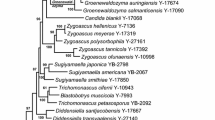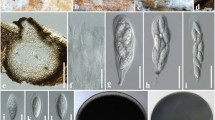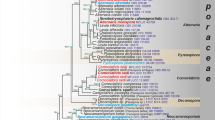Abstract
Parsimony network analysis of rDNA sequences was used to delimit phylogenetic species of yeasts in an objective, formal manner. Many strains assigned to Candida apicola (Starmerella clade), when compared to the type, fell outside the inclusion limits proposed by Kurtzman and Robnett (1998) based on a pair-wise comparison of the large subunit rRNA gene D1/D2 domains. However, when these sequences were analyzed jointly with ITS rDNA sequences by parsimony network analysis, 28 of the 30 strains formed a cohesive set. Two strains, MUCL 45721 and CBS 4353, were excluded from the species, but there was no evident justification to subdivide the rest. A similar analysis of 81 isolates originally assigned to Candida azyma (Wickerhamiella clade) yielded dramatically different results, giving rise to six independent networks corresponding to Candida azyma sensu stricto (18 strains), Candida azymoides (2 strains), a pair of isolates from Australian hibiscus flowers, a single isolate from the same substrate, a single isolate from Malaysian bertam palm nectar, and 57 isolates that are assigned to the new species Candida parazyma (type = UWOPS 91-652.1T = CBS 11563T = NRRL Y-48669T). The strains retained in C. azyma sensu stricto differed from one another by up to four substitutions in their D1/D2 sequences, but their polymorphism at the level of the ITS was considerable and suggested a history of divergence resulting from dispersal. Strains of C. parazyma fell into seven variant haplotypes based on sequences of the rDNA ITS and D1/D2 regions. The most abundant haplotype occurred across the global range of the species. Others were either endemic to Belize, Costa Rica, Rarotonga, or Tennessee, suggestive of vicariance, or occurred across remote localities, offering partial support to the notion of rapid dispersal.





Similar content being viewed by others
References
Clement M, Posada D, Crandall K (2000) TCS: a computer program to estimate gene genealogies. Mol Ecol 9:1657–1660
Darwin C (1859) On the origin of species by means of natural selection, or the preservation of favoured races in the struggle for life, 1st edn. John Murray, London, p 502
Fell JW, Boekhout T, Fonseca A, Scorzetti G, Statzell-Tallman A (2000) Biodiversity and systematics of basidiomycetous yeasts as determined by large-subunit rDNA D1/D2 domain sequence analysis. Int J Syst Evol Microbiol 50:1351–1371
Fenchel T, Finlay BJ (2004) The ubiquity of small species: patterns of local and global diversity. Bioscience 54:777–784
Finlay BJ, Esteban GF, Brown S, Fenchel T, Hoef-Emden K (2006) Multiple cosmopolitan ecotypes within a microbial eukaryote morphospecies. Protist 157:377–390
Greig D (2007) Population biology: wild origins of a model yeast. Curr Biol 17:R251–R253
Groenewald M, Daniel HM, Robert V, Poot GA, MTh Smith (2008) Polyphasic re-examination of Debaryomyces hansenii strains and reinstatement of D. hansenii, D. fabryi and D. subglobosus. Persoonia 21:17–27
Hart M, Sunday J (2007) Things fall apart: biological species form unconnected parsimony networks. Biol Lett 3:509–512
Jacques N, Mallet S, Casaregola S (2009) Delimitation of the species of the Debaryomyces hansenii complex by intron sequence analysis. Int J Syst Evol Microbiol 59:1242–1251
Kurtzman CP, Droby S (2001) Metschnikowia fructicola, a new ascosporic yeast with potential for biocontrol of postharvest fruit rots. Syst Appl Microbiol 24:395–399
Kurtzman CP, Robnett CJ (1998) Identification and phylogeny of ascomycetous yeasts from analysis of nuclear large subunit (26S) ribosomal DNA partial sequences. Antonie van Leeuwenhoek 73:331–371
Kurtzman CP, Robnett CJ (2003) Identification of clinically important ascomycetous yeasts based on nucleotide divergence in the 5′ end of the large-subunit (26S) ribosomal DNA gene. J Clin Microbiol 35:1216–1223
Lachance MA (1993) Kluyveromyces: systematics since 1970. Antonie van Leeuwenhoek 63:95–104
Lachance MA, Bowles JM, Mueller C, Starmer WT (2000) On the biogeography of yeasts in the Wickerhamiella clade and description of Wickerhamiella lipophila sp. nov., the teleomorph of Candida lipophila. Can J Microbiol 46:1145–1148
Lachance MA, Bowles JM, Kwon S, Marinoni G, Starmer WT, Janzen DH (2001) Metschnikowia lochheadii and Metschnikowia drosophilae, two new yeast species isolated from insects associated with flowers. Can J Microbiol 47:103–109
Lachance MA, Daniel HM, Meyer W, Prasad GS, Gautam SP, Boundy-Mills K (2003) The D1/D2 domain of the large subunit rDNA of the yeast species Clavispora lusitaniae is unusually polymorphic. FEMS Yeast Res 4:253–258
Lachance MA, Ewing CP, Bowles JM, Starmer WT (2005) Metschnikowia hamakuensis sp. nov., Metschnikowia kamakouana sp. nov., and Metschnikowia mauinuiana sp. nov., three endemic yeasts from Hawaiian nitidulid beetles. Int J Syst Evol Microbiol 55:1369–1377
Lachance MA, Lawrie D, Dobson J, Piggott J (2008) Biogeography and population structure of the Neotropical endemic yeast species Metschnikowia lochheadii. Antonie van Leeuwenhoek 94:403–414
Liti G, Carter DM, Moses AM et al (2009) Population genomics of domestic and wild yeasts. Nature 458:337–341
Marinoni G, Lachance MA (2004) Speciation in the large-spored Metschnikowia clade and establishment of a new species, Metschnikowia borealis comb. nov. FEMS Yeast Res 4:587–596
Meyer SA, Payne RW, Yarrow D (1998) Candida Berkhout. In: Kurtzman CP, Fell JW (eds) The yeasts, a taxonomic study, 4th edn. Elsevier, Amsterdam, pp 454–573
Molnár O, Prillinger H (2005) Analysis of yeast isolates related to Metschnikowia pulcherrima using the partial sequences of the large subunit rDNA and the actin gene; description of Metschnikowia andauensis sp. nov. Syst Appl Microbiol 28:717–726
Nguyen HV, Gaillardin C, Neuvéglise C (2009) Differentiation of Debaryomyces hansenii and Candida famata by rRNA gene intergenic spacer fingerprinting and reassessment of phylogenetic relationships among D. hansenii, C. famata, D. fabryi, C. flareri (= D. subglobosus) and D. prosopidis: description of D. vietnamensis sp. nov. closely related to D. nepalensis. FEMS Yeast Res 9:641–662
Posada D, Crandall KA (2001) Intraspecific gene genealogies: trees grafting into networks. Trends Ecol Evol 16:37–45
Rosa CA, Lachance MA, Silva J, Teixeira A, Marini MM, Antonini Y, Martins RP (2003) Yeast communities associated with stingless bees. FEMS Yeast Res 4:271–275
Rosa CA, Morais PB, Lachance MA, Pimenta RS, Santos RO, Trindade RC, Figueroa DL, Resende MA, Bragança MAL (2006) Candida azymoides sp. n., a yeast species from tropical fruits and larva (Ascomycota) of Anastrepha mucronota (Diptera: Tephritidae). Lundiana 7:83–86
Seifert KA (2009) Barcoding fungi. Progress towards DNA barcoding of fungi. Mol Ecol Resour 9(Suppl 1):83–89
Sipiczki M (2006) Metschnikowia strains isolated from botrytized grapes antagonize fungal and bacterial growth by iron depletion. Appl Environ Microbiol 72:6716–6724
Suh SO, Gibson CM, Blackwell M (2004a) Metschnikowia chrysoperlae sp. nov., Candida picachoensis sp. nov. and Candida pimensis sp. nov., isolated from the green lacewings Chrysoperla comanche and Chrysoperla carnea (Neuroptera: Chrysopidae). Int J Syst Evol Microbiol 54:1883–1890
Suh SO, McHugh JV, Blackwell M (2004b) Expansion of the Candida tanzawaensis yeast clade: 16 novel Candida species from basidiocarp-feeding beetles. Int J Syst Evol Microbiol 54:2409–2429
Taylor JW, Jacobson DJ, Kroken S, Kasuga T, Geiser DM, Hibbett DS, Fisher MC (2000) Phylogenetic species recognition and species concepts in Fungi. Fungal Genet Biol 31:21–32
Templeton AR, Crandall KA, Sing CF (1992) A cladistic analysis of phenotypic associations with haplotypes inferred from restriction endonuclease mapping and DNA sequence data. III. Cladogram estimation. Genetics 132:619–633
Wardlaw AM, Berkers TE, Man KC, Lachance MA (2009) Population structure of two beetle-associated yeasts: comparison of a New World asexual and an endemic Nearctic sexual species in the Metschnikowia clade. Antonie van Leeuwenhoek 96:1–15
Webster AJ, Payne RJ, Pagel M (2003) Molecular phylogenies link rates of evolution and speciation. Science 301:478
Wright S, Keeling J, Gillman L (2006) The road from Santa Rosalia: a faster tempo of evolution in tropical climates. Proc Natl Acad Sci USA 103:7718–7722
Xue ML, Zhang LQ, Wang QM, Zhang JS, Bai FY (2006) Metschnikowia sinensis sp. nov., Metschnikowia zizyphicola sp. nov. and Metschnikowia shanxiensis sp. nov., novel yeast species from jujube fruit. Int J Syst Evol Microbiol 56:2245–2250
Yarrow D (1998) Methods for the isolation and identification of yeasts. In: Kurtzman CP, Fell JW (eds) The yeasts, a taxonomic study, 4th edn. Elsevier, Amsterdam, pp 77–100
Acknowledgments
This work was funded by the Natural Science and Engineering Research Council of Canada. We acknowledge the gift of strains from the Centraalbureau voor Schimmelcultures, The Netherlands (V. Robert, M. Groenewald), the Mycothèque de l’Université catholique de Louvain, Belgium (H.M. Daniel), the BIOTEC Culture collection, Thailand (S. Jindamorakot), as well as the research collections of C.A. Rosa and W.T. Starmer. We also benefited from the field collaboration of numerous individuals, including J.S.F. Barker, J.M. Bowles, D.H. Janzen, J. McNeil, M. Polak, and others. Special thanks are owed to C. Harding for the Belize collection.
Author information
Authors and Affiliations
Corresponding author
Rights and permissions
About this article
Cite this article
Lachance, MA., Dobson, J., Wijayanayaka, D.N. et al. The use of parsimony network analysis for the formal delineation of phylogenetic species of yeasts: Candida apicola, Candida azyma, and Candida parazyma sp. nov., cosmopolitan yeasts associated with floricolous insects. Antonie van Leeuwenhoek 97, 155–170 (2010). https://doi.org/10.1007/s10482-009-9399-3
Received:
Accepted:
Published:
Issue Date:
DOI: https://doi.org/10.1007/s10482-009-9399-3




